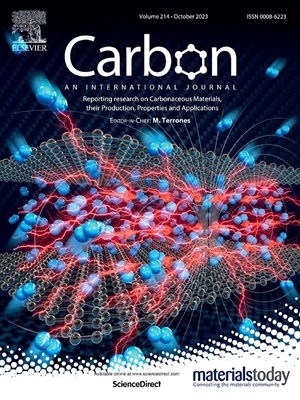High conductivity and low cost carbon composite hot pressed bipolar plate with gradient distribution of expanded graphite and polypropylene components
IF 10.5
2区 材料科学
Q1 CHEMISTRY, PHYSICAL
引用次数: 0
Abstract
(VRFB) is a leading energy storage technology due to its high safety and extended cycle life. As one of the cell stack key materials, the carbon-polymer composite hot pressed bipolar plate has a higher electric conductivity than the corresponding extruded bipolar plate because of the lower resin, which is favorable for the large scale high power density cell stack. The distribution of conductive carbon and resin significantly affects electrical conductivity, mechanical strength, and area specific resistance. Therefore, balancing these three factors has become a key research focus. This paper proposes a novel hot pressed bipolar plate with a gradient distribution of flexible conductive expanded graphite (EG) and polypropylene (PP), produced with multi-layer gradient structures via multi-pass compression molding. Replacing traditional PVDF resin with low-cost PP, the plate achieves a high electrical conductivity of 410.78 S/cm, flexural strength of 30.8 MPa, and an are specific resistance of 10.8 mΩ cm2. At a current density of 200 mA/cm2, the voltage and energy efficiencies of 83.07 % and 79.83 %, respectively. These findings demonstrate that multi-layer gradient structures effectively balance mechanical properties, electrical conductivity, and contact resistance at low cost, offering a new approach for bipolar plate material development.

具有梯度分布的膨胀石墨和聚丙烯组分的高导电性和低成本的碳复合热压双极板
(VRFB)因其高安全性和延长循环寿命而成为领先的储能技术。碳-聚合物复合热压双极板作为电池堆的关键材料之一,由于树脂含量较低,其电导率高于相应的挤压双极板,有利于大规模的高功率密度电池堆。导电碳和树脂的分布对电导率、机械强度和面积比电阻有显著影响。因此,如何平衡这三个因素就成为了研究的重点。提出了一种梯度分布柔性导电膨胀石墨(EG)和聚丙烯(PP)的新型热压双极板,该板采用多层梯度结构,经多道次压缩成型而成。用低成本的PP代替传统的PVDF树脂,实现了410.78 S/cm的高电导率,30.8 MPa的抗弯强度,10.8 mΩ cm2的比电阻。在电流密度为200 mA/cm2时,电压和能量效率分别为83.07%和79.83%。这些发现表明,多层梯度结构可以有效地以低成本平衡机械性能、电导率和接触电阻,为双极板材料的发展提供了新的途径。
本文章由计算机程序翻译,如有差异,请以英文原文为准。
求助全文
约1分钟内获得全文
求助全文
来源期刊

Carbon
工程技术-材料科学:综合
CiteScore
20.80
自引率
7.30%
发文量
0
审稿时长
23 days
期刊介绍:
The journal Carbon is an international multidisciplinary forum for communicating scientific advances in the field of carbon materials. It reports new findings related to the formation, structure, properties, behaviors, and technological applications of carbons. Carbons are a broad class of ordered or disordered solid phases composed primarily of elemental carbon, including but not limited to carbon black, carbon fibers and filaments, carbon nanotubes, diamond and diamond-like carbon, fullerenes, glassy carbon, graphite, graphene, graphene-oxide, porous carbons, pyrolytic carbon, and other sp2 and non-sp2 hybridized carbon systems. Carbon is the companion title to the open access journal Carbon Trends. Relevant application areas for carbon materials include biology and medicine, catalysis, electronic, optoelectronic, spintronic, high-frequency, and photonic devices, energy storage and conversion systems, environmental applications and water treatment, smart materials and systems, and structural and thermal applications.
 求助内容:
求助内容: 应助结果提醒方式:
应助结果提醒方式:


